Cosplay
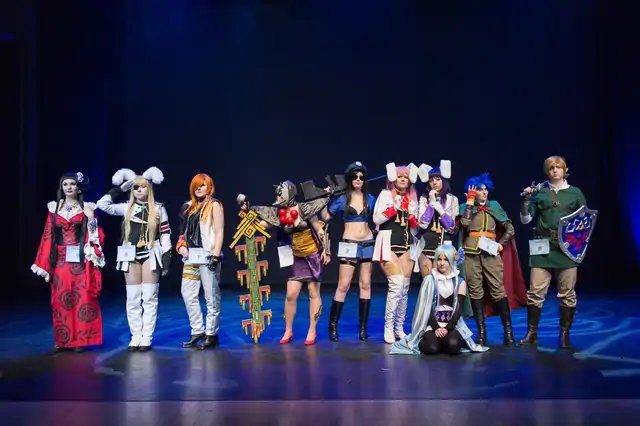
Cosplay

| [[INLINE_IMAGE|https://upload.wikimedia.org/wikipedia/commons/thumb/1/1b/Nuvola_apps_kaboodle.svg/16px-Nuvola_apps_kaboodle.svg.png|//upload.wikimedia.org/wikipedia/commons/thumb/1/1b/Nuvola_apps_kaboodle.svg/24px-Nuvola_apps_kaboodle.svg.png 1.5x, //upload.wikimedia.org/wikipedia/commons/thumb/1/1b/Nuvola_apps_kaboodle.svg/32px-Nuvola_apps_kaboodle.svg.png 2x||h16|w16]][1]A cinéma vérité view of participants in the 2017 [[Japan Ultra}]] |
_%E2%80%A2_2.jpg)
A model cosplaying Ciri, one of the main characters of The Witcher 3: Wild Hunt
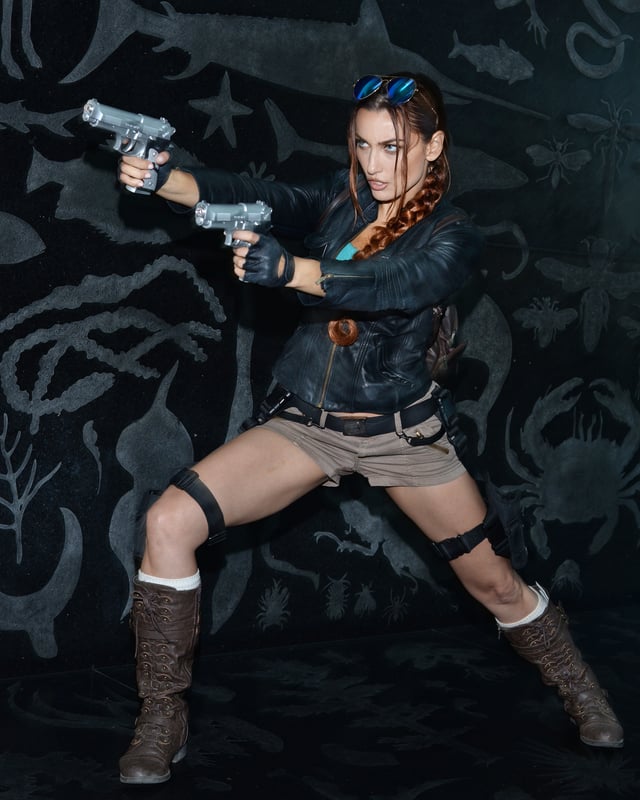
Cosplay of Lara Croft by Tatiana DeKhtyar at the E3 Expo in Los Angeles 2016
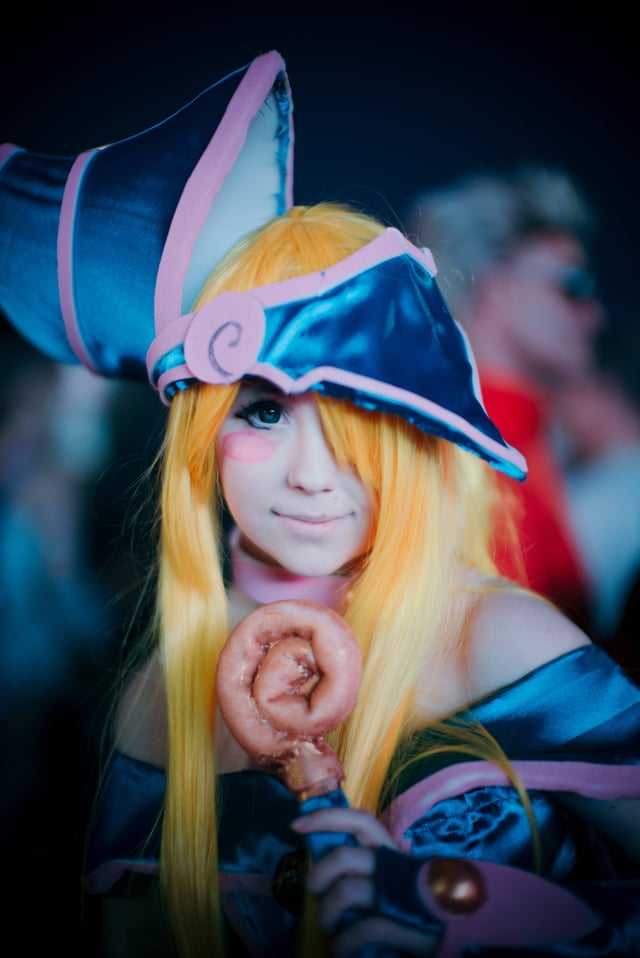
Cosplay of the Yu-Gi-Oh! character "Dark Magician Girl" by Megumi Koneko at MCM Comic Con in London 2016
Cosplay (コスプレ,kosupure), a portmanteau of the words costume play, is a performance art in which participants called cosplayers wear self-made costumes and fashion accessories to represent a specific character. Cosplayers often interact to create a subculture, and a broader use of the term "cosplay" applies to any costumed role-playing in venues apart from the stage. Any entity that lends itself to dramatic interpretation may be taken up as a subject and it is not unusual to see genders switched. Favorite sources include anime, cartoons, comic books, manga, live-action films, television series, and video games.
The rapid growth in the number of people cosplaying as a hobby since 1990s has made the phenomenon a significant aspect of popular culture in Japan and some other parts of Asia and in the Western world. Cosplay events are common features of fan conventions and there are also dedicated conventions and local and international competitions, as well as social networks, websites and other forms of media centered on cosplay activities.
The term "cosplay" was coined in Japan in 1984.
It was inspired by and grew out of the practice then-known as fan costuming at science fiction conventions, beginning with Morojo's "futuristicostumes" created for the 1st World Science Fiction Convention in New York City in 1939.
| [[INLINE_IMAGE|https://upload.wikimedia.org/wikipedia/commons/thumb/1/1b/Nuvola_apps_kaboodle.svg/16px-Nuvola_apps_kaboodle.svg.png|//upload.wikimedia.org/wikipedia/commons/thumb/1/1b/Nuvola_apps_kaboodle.svg/24px-Nuvola_apps_kaboodle.svg.png 1.5x, //upload.wikimedia.org/wikipedia/commons/thumb/1/1b/Nuvola_apps_kaboodle.svg/32px-Nuvola_apps_kaboodle.svg.png 2x||h16|w16]][1]A cinéma vérité view of participants in the 2017 [[Japan Ultra}]] |
Etymology
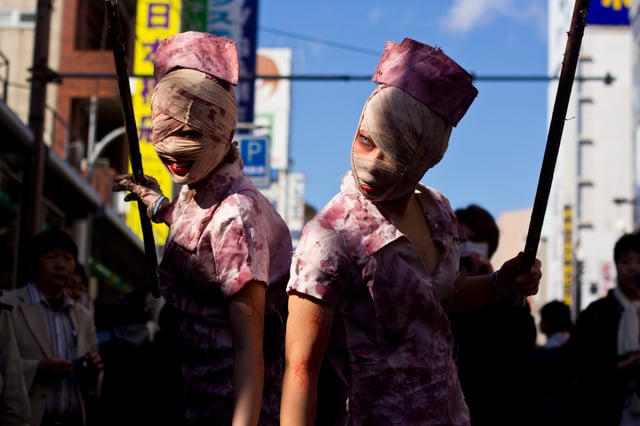
*Silent Hill * cosplayers at the 2014 Nipponbashi Street Festa in Osaka
The term "cosplay" is a Japanese portmanteau of the English terms costume and play. The term was coined by Nobuyuki Takahashi of Studio Hard [93] after he attended the 1984 World Science Fiction Convention (Worldcon) in Los Angeles [106] and saw costumed fans, which he later wrote about in an article for the Japanese magazine My Anime. [93] Takahashi chose to coin a new word rather than use the existing translation of the English term "masquerade" because that translates into Japanese as "an aristocratic costume", which did not match his experience of the WorldCon. [17] The coinage reflects a common Japanese method of abbreviation in which the first two moras of a pair of words are used to form an independent compound: 'costume' becomes kosu (コス) and 'play' becomes pure (プレ).
History
Pre-20th century
Masquerade balls were a feature of the Carnival season in the 15th century, and involved increasingly elaborate allegorical Royal Entries, pageants, and triumphal processions celebrating marriages and other dynastic events of late medieval court life. They were extended into costumed public festivities in Italy during the 16th century Renaissance, generally elaborate dances held for members of the upper classes, which were particularly popular in Venice.
Costume parties (American English) or fancy dress parties (British English) were popular from the 19th century onwards.
Costuming guides of the period, such as Samuel Miller's Male Character Costumes (1884) [50] or Ardern Holt's *Fancy Dresses Described * (1887), [57] feature mostly generic costumes, whether that be period costumes, national costumes, objects or abstract concepts such as "Autumn" or "Night". Most specific costumes described therein are for historical figures although some are sourced from fiction, like *The Three Musketeers * or Shakespeare characters.
Fan costuming
.jpg)
Costuming at the 1982 San Diego Comic-Con.
A.D. Condo's science fiction comic strip character Mr. Skygack, from Mars (a Martian ethnographer who comically misunderstands many Earthly affairs) is arguably the first fictional character that people emulated by wearing costumes, as in 1908 Mr. and Mrs. William Fell of Cincinnati, Ohio are reported to have attended a masquerade at a skating rink wearing Mr. Skygack and Miss Dillpickles costumes. Later, in 1910, an unnamed woman won first prize at masquerade ball in Tacoma, Washington wearing another Skygack costume. [89]
The first people to wear costumes to attend a convention were science fiction fans Forrest J Ackerman and Myrtle R. Douglas, known in fandom as Morojo. They attended the 1939 1st World Science Fiction Convention (Nycon or 1st Worldcon) in the Caravan Hall, New York, USA dressed in "futuristicostumes", including green cape and breeches, based on the pulp magazine artwork of Frank R. Paul and the 1936 film *Things to Come *, designed and created by Douglas. [20] [27] Ackerman later stated that he thought everyone was supposed to wear a costume at a science fiction convention, although only he and Douglas did.
Fan costuming caught on, however, and the 2nd Worldcon (1940) had both an unofficial masquerade held in Douglas' room and an official masquerade as part of the programme. [106] David Kyle won the masquerade wearing a Ming the Merciless costume created by Leslie Perri, while Robert A. W. Lowndes received second place with a Bar Senestro costume (from the novel *The Blind Spot * by Austin Hall and Homer Eon Flint). Other costumed attendees included guest of honor E. E. Smith as Northwest Smith (from C. L. Moore's series of short stories) and both Ackerman and Douglas wearing their futuristicostumes again. Masquerades and costume balls continued to be part of World Science Fiction Convention tradition thereafter. Early Worldcon masquerade balls featured a band, dancing, food and drinks. Contestants either walked across a stage or a cleared area of the dance floor.
Ackerman wore a "Hunchbackerman of Notre Dame" costume to the 3rd Worldcon (1941), which included a mask designed and created by Ray Harryhausen, but soon stopped wearing costumes to conventions. Douglas wore an Akka costume (from A. Merritt's novel *The Moon Pool *), the mask again made by Harryhausen, to the 3rd Worldcon and a Snake Mother costume (another Merritt costume, from *The Snake Mother *) to the 4th Worldcon (1946). [83]
Rules governing costumes became established in response to specific costumes and costuming trends.
The first nude contestant at a Worldcon masquerade was in 1952; but the height of this trend was in the 1970s and early 1980s, with a few every year.
This eventually led to "No Costume is No Costume" rule, which banned full nudity, although partial nudity was still allowed as long as it was a legitimate representation of the character.
Mike Resnick describes the best of the nude costumes as Kris Lundi wearing a harpy costume to the 32nd Worldcon (1974) (she received an honorable mention in the competition). [95] [104] Another costume that instigated a rule change was an attendee at the 20th Worldcon (1962) whose blaster prop fired a jet of real flame; which led to fire being banned. At the 30th WorldCon (1972), artist Scott Shaw wore a costume composed largely of peanut butter to represent his own underground comix character called "The Turd". The peanut butter rubbed off, doing damage to soft furnishings and other peoples' costumes, and then began to go rancid under the heat of the lighting. Food, odious, and messy substances were banned as costume elements after that event. [110] [4] [14]
Costuming spread with the science fiction conventions and the interaction of fandom. The earliest known instance of costuming at a convention in the United Kingdom was at the London Science Fiction Convention (1953) but this was only as part of a play. However, members of the Liverpool Science Fantasy Society attended the 1st Cytricon (1955), in Kettering, wearing costumes and continued to do so in subsequent years. [-1] The 15th Worldcon (1957) brought the first official convention masquerade to the UK. [-1] The 1960 Eastercon in London may have been the first British-based convention to hold an official fancy dress party as part of its programme. [-1] The joint winners were Ethel Lindsay and Ina Shorrock as two of the titular witches from the novel *The Witches of Karres * by James H. Schmitz. [-1]
In Japan, costuming at conventions was a fan activity from at least the 1970s, especially after the launch of the Comiket convention in December 1975. Costuming at this time was known as kasou (仮想). The first documented case of costuming at a fan event in Japan was at Ashinocon (1978), in Hakone, at which future science fiction critic Mari Kotani wore a costume based on the cover art for Edgar Rice Burroughs' novel *A Fighting Man of Mars *. [46] In an interview Kotani states that there were about twenty costumed attendees at the convention's costume party—made up of members of her *Triton of the Sea * fan club and Kansai Entertainers (関西芸人,Kansai Geinin), antecedent of the Gainax anime studio—with most attendees in ordinary clothing. [46] One of the Kansai group, an unnamed friend of Yasuhiro Takeda, wore an impromptu Tusken Raider costume (from the film *Star Wars *) made from one of the host-hotel's rolls of toilet paper. Costume contests became a permanent part of the Nihon SF Taikai conventions from Tokon VII in 1980.
Possibly the first costume contest held at a comic book convention was at the 1st Academy Con held at Broadway Central Hotel, New York in August 1965. Roy Thomas, future editor-in-chief of Marvel Comics but then just transitioning from a fanzine editor to a professional comic book writer, attended in a Plastic Man costume.
The first Masquerade Ball held at San Diego Comic-Con was in 1974 during the convention's 6th event. Voice actress June Foray was the master of ceremonies. [74] Future scream queen Brinke Stevens won first place wearing a Vampirella costume. [84] [87] Forrest J Ackerman, the creator of Vampirella, was in attendance and posed with Stevens for photographs. They became friends and, according to Stevens "Forry and his wife, Wendayne, soon became like my god parents." Photographer Dan Golden saw a photograph of Stevens in the Vampirella costume while visiting Ackerman's house, leading to him hiring her for a non-speaking role in her first student film, Zyzak is King (1980), and later photographing her for the cover of the first issue of *Femme Fatales * (1992). Stevens attributes these events to launching her acting career.
As early as a year after the 1975 release of *The Rocky Horror Picture Show *, audience members began dressing as characters from the movie and role-playing (although the initial incentive for dressing-up was free admission) in often highly accurate costumes. [101]
Cosplay
In 1984, Nobuyuki Takahashi, founder of Studio Hard, attended the 42nd Worldcon in Los Angeles. He was impressed with the masquerade and reported on it in My Anime, coining the term kosupure (from which cosplay is derived) in the process. His report also encouraged Japanese fans to include more costuming in their own conventions. [93] [106] [17] The initial report also used the terms "costume play" (コスチュームプレイ,kosuchuumu purei) and the English "Hero Costume Operation" but kosupure was the term that caught on.
As stated above, costuming had been a fan activity in Japan from the 1970s, and it became much more popular in the wake of Takahashi's report.
The new term did not catch on immediately, however.
It was a year or two after the article was published before it was in common use among fans at conventions.
It was in the 1990s, after exposure on television and in magazines, that the term and practice of cosplaying became common knowledge in Japan.
The first cosplay cafés appeared in the Akihabara area of Tokyo in the late 1990s. [106] [9] A temporary maid café was set up at the Tokyo Character Collection event in August 1998 to promote the video game *Welcome to Pia Carrot 2 * (1997). [9] An occasional Pia Carrot Restaurant was held at the shop Gamers in Akihabara in the years up to 2000. [9] Being linked to specific intellectual properties limited the lifespan of these cafés, which was solved by using generic maids, leading to the first permanent establishment, Cure Maid Café, which opened in March 2001. [9]
The first World Cosplay Summit was held on October 12, 2003 at the Rose Court Hotel in Nagoya, Japan, with five cosplayers invited from Germany, France and Italy. There was no contest until 2005, when the World Cosplay Championship began. The first winners were the Italian team of Giorgia Vecchini, Francesca Dani and Emilia Fata Livia.
Worldcon masquerade attendance peaked in the 1980s and started to fall thereafter.
This trend was reversed when the concept of cosplay was re-imported from Japan.
Practice of cosplay
Cosplay costumes vary greatly and can range from simple themed clothing to highly detailed costumes.
It is generally considered different from Halloween and Mardi Gras costume wear, as the intention is to replicate a specific character, rather than to reflect the culture and symbolism of a holiday event. As such, when in costume, some cosplayers often seek to adopt the affect, mannerisms, and body language of the characters they portray (with "out of character" breaks). The characters chosen to be cosplayed may be sourced from any movie, TV series, book, comic book, video game, music band, anime, or manga. Some cosplayers even choose to cosplay an original character of their own design or a fusion of different genres (e.g., a steampunk version of a character), and it is a part of the ethos of cosplay that anybody can be anything, as with genderbending or drag, a cosplayer playing a character of another ethnicity, or a hijabi portraying Captain America. [29] [35]
Costumes
.jpg)
Padmé Amidala cosplay at Japan Expo 2012 in France
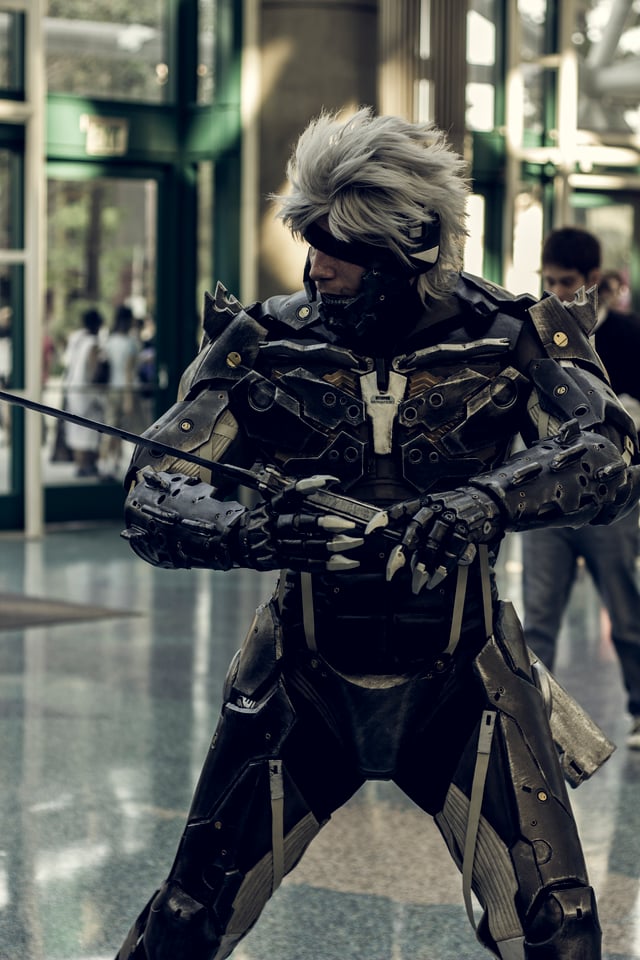
Jeff "Xailas" Siegert cosplaying as Raiden at Anime Expo 2013

Ginny Weasley cosplay from the Harry Potter franchise
Cosplayers obtain their apparel through many different methods.
Manufacturers produce and sell packaged outfits for use in cosplay, with varying levels of quality.
These costumes are often sold online, but also can be purchased from dealers at conventions.
Japanese manufacturers of cosplay costumes reported a profit of 35 billion yen in 2008.
[40] A number of individuals also work on commission, creating custom costumes, props, or wigs designed and fitted to the individual. Other cosplayers, who prefer to create their own costumes, still provide a market for individual elements, and various raw materials, such as unstyled wigs, hair dye, cloth and sewing notions, liquid latex, body paint, costume jewelry, and prop weapons.
Cosplay represents an act of embodiment. Cosplay has been closely linked to the presentation of self, [49] yet cosplayers' ability to perform is limited by their physical features. The accuracy of a cosplay is judged based on the ability to accurately represent a character through the body, and individual cosplayers frequently are faced by their own "bodily limits"[52] such as level of attractiveness, body size, and disability [60] that often restrict and confine how accurate the cosplay is perceived to be. Authenticity is measured by a cosplayer's individual ability to translate on-screen manifestation to the cosplay itself. Some have argued that cosplay can never be a true representation of the character; instead, it can only be read through the body, and that true embodiment of a character is judged based on nearness to the original character form. [63] Cosplaying can also help some of those with self-esteem problems. [68] [76]
Many cosplayers create their own outfits, referencing images of the characters in the process.
In the creation of the outfits, much time is given to detail and qualities, thus the skill of a cosplayer may be measured by how difficult the details of the outfit are and how well they have been replicated.
Because of the difficulty of replicating some details and materials, cosplayers often educate themselves in crafting specialties such as textiles, sculpture, face paint, fiberglass, fashion design, woodworking, and other uses of materials in the effort to render the look and texture of a costume accurately. [85] Cosplayers often wear wigs in conjunction with their outfit to further improve the resemblance to the character. This is especially necessary for anime and manga or video-game characters who often have unnaturally coloured and uniquely styled hair. Simpler outfits may be compensated for their lack of complexity by paying attention to material choice and overall high quality.
To look more like the characters they are portraying, cosplayers might also engage in various forms of body modification. Cosplayers may opt to change their skin color utilizing bleach or make-up to more simulate the race of the character they are adopting. [88] Contact lenses that match the color of their characters' eyes are a common form of this, especially in the case of characters with particularly unique eyes as part of their trademark look. Contact lenses that make the pupil look enlarged to visually echo the large eyes of anime and manga characters are also used. [94] Another form of body modification in which cosplayers engage is to copy any tattoos or special markings their character might have. Temporary tattoos, permanent marker, body paint, and in rare cases, permanent tattoos, are all methods used by cosplayers to achieve the desired look. Permanent and temporary hair dye, spray-in hair coloring, and specialized extreme styling products are all used by some cosplayers whose natural hair can achieve the desired hairstyle. It is also commonplace for them to shave off their eyebrows to gain a more accurate look.
Some anime and video game characters have weapons or other accessories that are hard to replicate, and conventions have strict rules regarding those weapons, but most cosplayers engage in some combination of methods to obtain all the items necessary for their costumes; for example, they may commission a prop weapon, sew their own clothing, buy character jewelry from a cosplay accessory manufacturer, or buy a pair of off-the-rack shoes, and modify them to match the desired look.
Presentation
Cosplay may be presented in a number of ways and places.
A subset of cosplay culture is centered on sex appeal, with cosplayers specifically choosing characters known for their attractiveness or revealing costumes. However, wearing a revealing costume can be a sensitive issue while appearing in public. [97] [100] [105] People appearing naked at American science fiction fandom conventions during the 1970s were so common, a "no costume is no costume" rule was introduced. [111] Some conventions throughout the United States, such as Phoenix Comicon [2] and Penny Arcade Expo, [7] have also issued rules upon which they reserve the right to ask attendees to leave or change their costumes if deemed to be inappropriate to a family-friendly environment or something of a similar nature.
Conventions

A crowd including many cosplayers at Comiket 84 in 2013
The most popular form of presenting a cosplay publicly is by wearing it to a fan convention. Multiple conventions dedicated to anime and manga, comics, TV shows, video games, science fiction, and fantasy may be found all around the world. Cosplay-centered conventions include Cosplay Mania in the Philippines and EOY Cosplay Festival in Singapore.
The single largest event featuring cosplay is the semiannual *doujinshi * market, Comic Market (Comiket), held in Japan during summer and winter. Comiket attracts hundreds of thousands of manga and anime fans, where thousands of cosplayers congregate on the roof of the exhibition center. In North America, the highest-attended fan conventions featuring cosplayers are the San Diego Comic-Con and New York Comic Con held in the United States, and the anime-specific Anime North in Toronto, Otakon held in Baltimore MD and Anime Expo held in Los Angeles. Europe's largest event is Japan Expo held in Paris, while the London MCM Expo and the London Super Comic Convention are the most notable in the UK. Supanova Pop Culture Expo is Australia's biggest event.
Photography
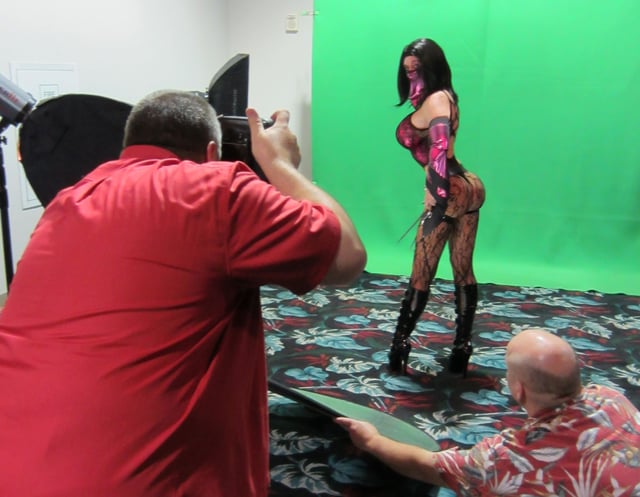
Professional photographers working with Mileena cosplayer for a chroma key studio photoshoot at Space City Con 2014 in the United States
The appearance of cosplayers at public events makes them a popular draw for photographers.
[18] As this became apparent in the late 1980s, a new variant of cosplay developed in which cosplayers attended events mainly for the purpose of modeling their characters for still photography rather than engaging in continuous role play. Rules of etiquette were developed to minimize awkward situations involving boundaries. Cosplayers pose for photographers and photographers do not press them for personal contact information or private sessions, follow them out of the area, or take photos without permission. The rules allow the collaborative relationship between photographers and cosplayers to continue with the least inconvenience to each other. [36]
Some cosplayers choose to have a professional photographer take high quality images of them in their costumes posing as the character.
Cosplayers and photographers frequently exhibit their work online and sometimes sell their images.
Competitions
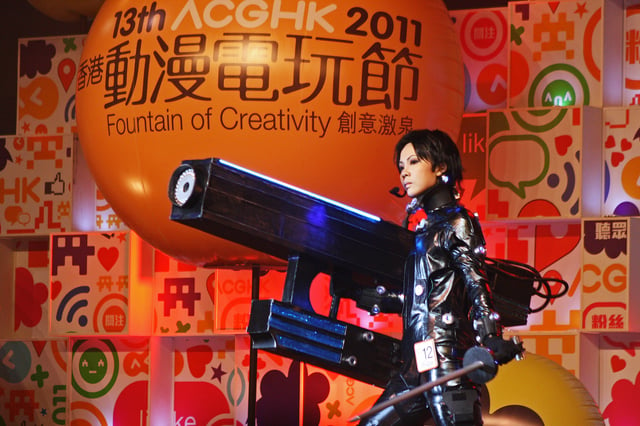
A cosplayer at the 2011 Animation-Comic-Game Hong Kong contest dressed as a character from *Gantz *
As the popularity of cosplay has grown, many conventions have come to feature a contest surrounding cosplay that may be the main feature of the convention.
Contestants present their cosplay, and often to be judged for an award, the cosplay must be self-made.
The contestants may choose to perform a skit, which may consist of a short performed script or dance with optional accompanying audio, video, or images shown on a screen overhead.
Other contestants may simply choose to pose as their characters.
Often, contestants are briefly interviewed on stage by a master of ceremonies. The audience is given a chance to take photos of the cosplayers. Cosplayers may compete solo or in a group. Awards are presented, and these awards may vary greatly. Generally, a best cosplayer award, a best group award, and runner-up prizes are given. Awards may also go to the best skit and a number of cosplay skill subcategories, such as master tailor, master weapon-maker, master armourer, and so forth.
The most well-known cosplay contest event is the World Cosplay Summit, selecting cosplayers from 20 countries to compete in the final round in Nagoya, Japan. Some other international events include European Cosplay Gathering (finals taking place at Japan Expo in Paris, France), [50] EuroCosplay (finals taking place at London MCM Expo), [50] and the Nordic Cosplay Championship (finals taking place at NärCon in Linköping, Sweden). [50]
Common Cosplay Judging Criteria
| Criteria | Description | Example |
|---|---|---|
| Accuracy | Resemblance to the original character in terms of appearance. |
|
| Craftsmanship | Quality and details of the costume and props. |
|
| Presentation | Likeliness in terms of character portrayal and performance. |
|
| Audience Impact | Stage presence and connection with the audience. |
|
Gender issues
.jpg)
A female group crossplaying as Loki at Dragon Con 2012
Portraying a character of the opposite sex is called crossplay. The practicality of crossplay and cross-dress stems in part from the abundance in manga of male characters with delicate and somewhat androgynous features. Such characters, known as *bishōnen * (lit. "pretty boy"), [50] are Asian equivalent of the elfin boy archetype represented in Western tradition by figures such as Peter Pan and Ariel.
Male to female cosplayers may experience issues when trying to portray a female character because it is hard to maintain the sexualized femininity of a character.
Male cosplayers may also be subjected to discrimination, [50] including homophobic comments and being touched without permission.
This impacts men possibly even more often than it impacts women, despite inappropriate contact already being a problem for women who cosplay, [57] as is "slut-shaming". [57]
*Animegao kigurumi * players, a niche group in the realm of cosplay, are often male cosplayers who use zentai and stylized masks to represent female anime characters. These cosplayers completely hide their real features so the original appearance of their characters may be reproduced as literally as possible, and to display all the abstractions and stylizations such as oversized eyes and tiny mouths often seen in Japanese cartoon art. [57] This does not mean that only males perform animegao or that masks are only female.
Cosplay models
Cosplay has influenced the advertising industry, in which cosplayers are often used for event work previously assigned to agency models.
[18] Some cosplayers have thus transformed their hobby into profitable, professional careers.
[57] [25] [57] Japan's entertainment industry has been home to the professional cosplayers since the rise of Comiket and Tokyo Game Show. [18] The phenomenon is most apparent in Japan but exists to some degree in other countries as well. Professional cosplayers who profit from their art may experience problems related to copyright infringement. [57]
A cosplay model, also known as a cosplay idol, cosplays costumes for anime and manga or video game companies.
Good cosplayers are viewed as fictional characters in the flesh, in much the same way that film actors come to be identified in the public mind with specific roles.
Cosplayers have modeled for print magazines like Cosmode and a successful cosplay model can become the brand ambassador for companies like Cospa. Some cosplay models can achieve significant recognition. Yaya Han, for example, was described as having emerged "as a well-recognized figure both within and outside cosplay circuits". [25]
Cosplay by country or region
Cosplay in Japan
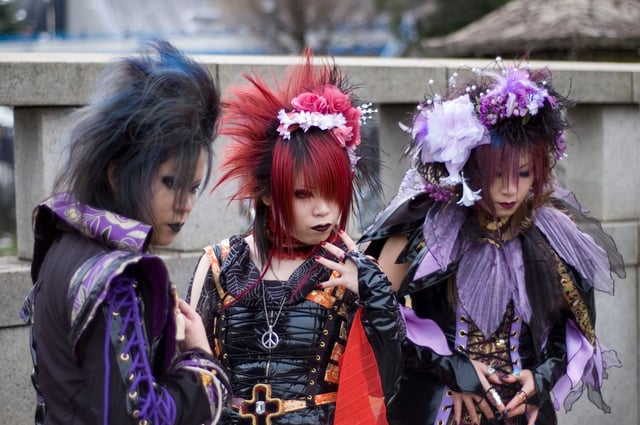
The Jingūbashi (Jingu Bridge) which passes over the Yamanote Line south of Harajuku Station, Tokyo, at the Meiji Shrine gate is a famous gathering place for cosplayers. Pictured, a group of people dressed as visual kei style musicians in 2006
Cosplayers in Japan used to refer to themselves as reiyā (レイヤー), pronounced "layer".
Currently in Japan, cosplayers are more commonly called kosupure (コスプレ), pronounced "ko-su-pray," as reiyā is more often used to describe layers (i.e. hair, clothes, etc.). [45] Those who photograph players are called cameko, short for camera kozō or camera boy.
Originally, the cameko gave prints of their photos to players as gifts.
Increased interest in cosplay events, both on the part of photographers and cosplayers willing to model for them, has led to formalization of procedures at events such as Comiket.
Photography takes place within a designated area removed from the exhibit hall.
In Japan, costumes are generally not welcome outside of conventions or other designated areas.
Since 1998, Tokyo's Akihabara district contains a number of cosplay restaurants, catering to devoted anime and cosplay fans, where the waitresses at such cafés dress as video game or anime characters; maid cafés are particularly popular. In Japan, Tokyo's Harajuku district is the favourite informal gathering place to engage in cosplay in public. Events in Akihabara also draw many cosplayers.
Cosplay in other Asian countries
Cosplay is common in many East Asian countries.
For example, it is a major part of the Comic World conventions taking place regularly in South Korea, Hong Kong and Taiwan. [57] Historically, the practice of dressing up as characters from works of fiction can be traced as far as the 17th century late Ming Dynasty China. [65]
Cosplay in Western countries
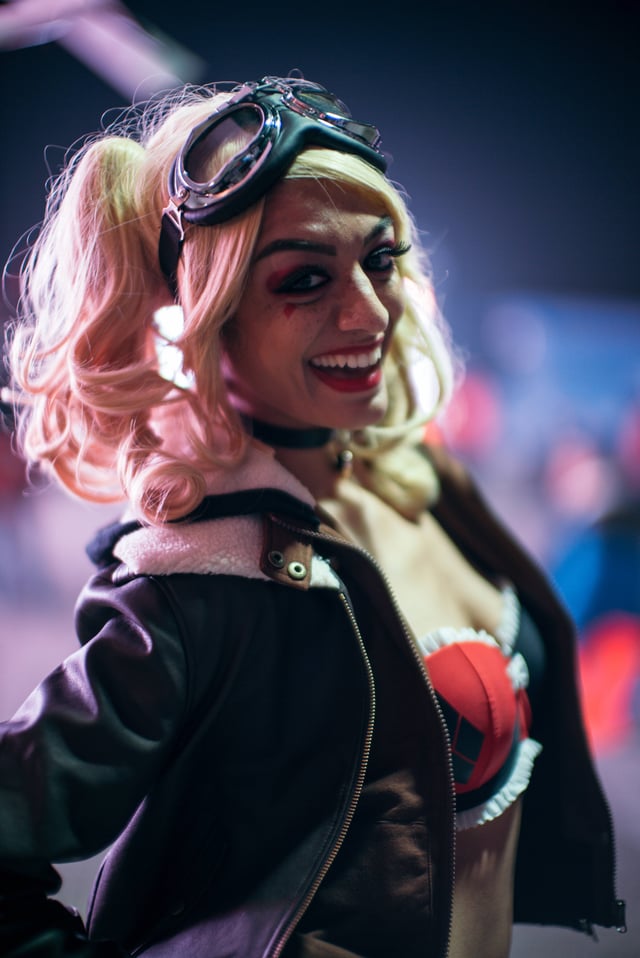
Bombshell Harley Quinn Cosplay
Western cosplay's origins are based primarily in science fiction and fantasy fandoms. It is also more common for Western cosplayers to recreate characters from live-action series than it is for Japanese cosplayers. Western costumers also include subcultures of hobbyists who participate in Renaissance faires, live action role-playing games, and historical reenactments. Competition at science fiction conventions typically include the masquerade (where costumes are presented on stage and judged formally) and hall costumes [65] (where roving judges may give out awards for outstanding workmanship or presentation). [65]
The increasing popularity of Japanese animation outside of Asia during the late 2000s led to an increase in American and other Western cosplayers who portray manga and anime characters.
Anime conventions have become more numerous in the West in the previous decade, now competing with science fiction, comic book and historical conferences in attendance.
At these gatherings, cosplayers, like their Japanese counterparts, meet to show off their work, be photographed, and compete in costume contests.
[65] Convention attendees also just as often dress up as Western comic book or animated characters, or as characters from movies and video games.
Differences in taste still exist across cultures: some costumes that are worn without hesitation by Japanese cosplayers tend to be avoided by Western cosplayers, such as outfits that evoke Nazi uniforms. Some Western cosplayers have also encountered questions of legitimacy when playing characters of canonically different racial backgrounds, [65] [65] and people can be insensitive to cosplayers playing as characters who are canonically of other skin color. [65] [65] Western cosplayers of anime characters may also be subjected to particular mockery. [65]
In contrast to Japan, the wearing of costumes in public is more accepted in the United States and other western countries.
These countries have a longer tradition of Halloween costumes, fan costuming and other such activities.
As a result, for example, costumed convention attendees can often be seen at local restaurants and eateries, beyond the boundaries of the convention or event.
Media
Magazines and books
Japan is home to two especially popular cosplay magazines, *Cosmode * (コスモード) and ASCII Media Works'Dengeki Layers (電撃Layers). [65] Cosmode has the largest share in the market and an English-language digital edition. [24] Another magazine, aimed at a broader, worldwide audience is CosplayGen. [26] In the United States, Cosplay Culture began publication in February 2015. [70] Other magazines include CosplayZine featuring cosplayers from all over the world since October 2015. [70] There are many books on the subject of cosplay as well. [70]
Documentaries and reality shows
Cosplay Encyclopedia, a 1996 film about Japanese cosplay released by Japan Media Supply. It was released in subtitled VHS by Anime Works in 1999, [70] eventually being released onto DVD in 2002. [70]
*Otaku Unite! *, a 2004 film about otaku subculture, features extensive footage of cosplayers.
Akihabara Geeks, a 2005 Japanese short film. [70]
Animania: The Documentary [73] is a 2007 film that explores the cosplay cultural phenomenon in North America, following four cosplayers from various ethnicities as they prepare to compete at Anime North, Canada's largest anime convention.
Conventional Dress is a short documentary about cosplay at Dragon Con made by Celia Pearce and her students in 2008. [70]
Cosplayers: The Movie, released in 2009 by Martell Brothers Studios for free viewing on YouTube [82] and Crunchyroll, [82] explores the anime subculture in North America with footage from anime conventions and interviews with fans, voice actors and artists.
"I'm a Fanboy", a 2009 episode of the MTV series *True Life *, focusing on fandom and cosplay. [103]
*Fanboy Confessional *, a 2011 Space Channel series that featured an episode on cosplay and cosplayers from the perspective of an insider.
*Comic-Con Episode IV: A Fan's Hope *, a 2011 film about four attendees of the San Diego Comic-Con, including a cosplayer.
America's Greatest Otaku, a 2011 TV series where contenders included cosplayers. [82]
Cosplayers UK: The Movie, a 2011 film following a small selection of cosplayers at the London MCM Expo. [82]
My Other Me: A Film About Cosplayers, chronicling a year in the life of three different cosplayers: a veteran cosplayer who launched a career from cosplay, a young 14-year-old first-timer, and a transgender man who found himself through cosplay. It was released in 2013 and was a featured segment on *The Electric Playground *. [16]
*Heroes of Cosplay *, a reality show on cosplay that premiered in 2013 on the Syfy network. It follows nine cosplayers as they create their costumes, travel to conventions and compete in contests. [82]
"24 Hours With A Comic Con Character", a segment from CNNMoney following around a known cosplayer while she prepared for and attended New York Comic Con. [82]
WTF is Cosplay?, a reality show that premiered in 2015 on the Channel 4 network. It follows six cosplayers throughout their day-to-day lives and what cosplay means to them. [82]
*Cosplay Melee *, a competition reality show on cosplay that premiered in 2017 on the Syfy network.
, a 90 minutes documentary that follows cosplayers during preparation and conventions in Canada, Japan and Romania. Includes a visit of Akihabara (Japan), a geek Mardi Gras parade in New Orleans and a historic overview explaining the origin of cosplay.
Other media
*Cosplay Complex *, a 2002 anime miniseries.
*Downtown no Gaki no Tsukai ya Arahende!! *, a Japanese TV variety show that includes the Cosplay Bus Tour series segment.
*Super Cosplay War Ultra *, a 2004 freeware fighting game.
A large number of erotic and pornographic films featuring cosplaying actresses; many of such films come from the Japanese company TMA. [82]
**, a news and media website featuring some of the very best cosplay from around the world.
Notable cosplayers
Cosplay groups and organizations
501st Legion
Rebel Legion
Mandalorian Mercs

.jpg)